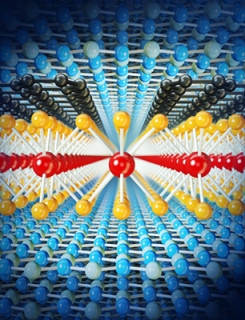Researchers at the Japanese National Institute of Materials Science, Danish Technical University, Yonsei University in Korea, University of Minnesota, Cornell, Harvard and Columbia Engineering have improved the performance of molybdenum disulfide (MoS2), a 2D material by encapsulating it in an insulating material, boron nitride (BN).
 Image Caption. Molybdenum disulfide encapsulated between layers of boron nitride (Credit: Gwan-Hyoung Lee/Yonsei University)
Image Caption. Molybdenum disulfide encapsulated between layers of boron nitride (Credit: Gwan-Hyoung Lee/Yonsei University)
A similar project was carried out by James Hone, Wang Fong-Jen Professor of Mechanical Engineering at Columbia Engineering and his colleagues in 2013. The work involved encapsulating a highly conducting 2D carbon material – graphene with BN of same layered structure to improve graphene’s performance.
“These findings provide a demonstration of how to study all 2D materials. Our combination of BN and graphene electrodes is like a ‘socket’ into which we can place many other materials and study them in an extremely clean environment to understand their true properties and potential. This holds great promise for a broad range of applications including high-performance electronics, detection and emission of light, and chemical/bio-sensing,” says Hone, leader of this new study and director of Columbia’s NSF-funded Materials Research Science and Engineering Center.
In general, atomically thin layers are peeled off the bulk crystals to form optically transparent and extremely stretchable 2D materials. These materials can be combined with each other and traditional electronics in different ways. However, these materials having the atoms at their surface respond to the environmental conditions. As a result, the performance of the materials drops below their theoretical limits with respect to the trapped charges and contamination in surrounding insulating layers.
The BN-encapsulated graphene produced by the Hone’s group feature 50× improved electronic mobility, which is a critical parameter of electronic performance. In addition, it has a lower disorder which facilitates new studies on phenomena at high magnetic fields and low temperature can be carried out.
We wanted to see what we could do with MoS2—it’s the best-studied 2D semiconductor, and, unlike graphene, it can form a transistor that can be switched fully ‘off’, a property crucial for digital circuits,
Gwan-Hyoung Lee, co-lead author on the paper
Previous studies show that the mobility of MoS2 devices produced by common insulating substrates like silicon dioxide fell short of theoretical limits, varied in every sample and remained at low temperatures upon cooling. These indications relate to a disordered material. However, the researchers were unable to conclude if the disorder is due to material imperfections or due to the substrate as in graphene.
The new work involves the creation of BN-encapsulated MoS2 in the form of layered stacks or heterostructures using small graphene flakes covering the MoS2 edges to provide electrical contacts. The findings showed that the mobility was improved in room temperature by a factor of 2, which is in close proximity to the intrinsic limit. They also observed a sudden increase in mobility values in the range of 5 to 50x based on the number of atomic layers. The samples also showed frequent oscillations in resistance corresponding to magnetic field, another indication of low disorder. This has not been observed in any 2D semiconductor before.
This new device structure enables us to study quantum transport behavior in this material at low temperature for the first time,
Columbia Engineering PhD student Xu Cui
By analyzing the low-temperature resistance and quantum oscillations, the team was able to conclude that the main source of disorder remains contamination at the interfaces, indicating that further improvements are possible.
Following the analysis of quantum oscillations and low-temperature resistance, the researchers concluded that the contamination formed at the interfaces is the root cause of the disorder. This also denotes further developments in the performance of 2D material.
“This work motivates us to further improve our device assembly techniques, since we have not yet reached the intrinsic limit for this material. With further progress, we hope to establish 2D semiconductors as a new family of electronic materials that rival the performance of conventional semiconductor heterostructures—but are created using scotch tape on a lab-bench instead of expensive high-vacuum systems,” Hone said.
The new research was published in the Advance Online Publication on Nature Nanotechnology’s website.
References